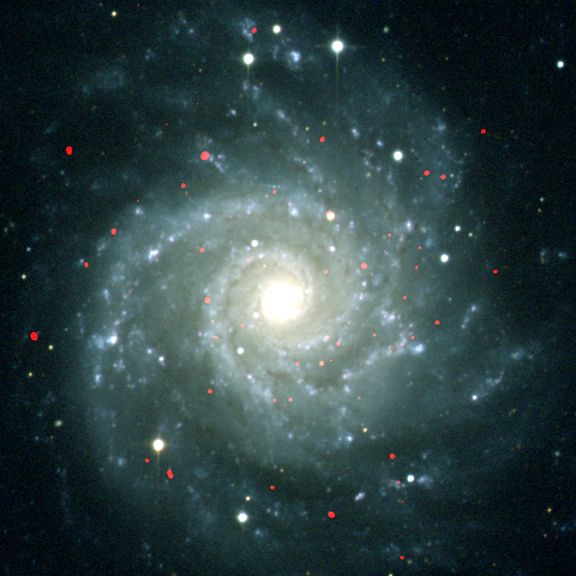Credit & Copyright: X-ray;
J. Liu (U.Mich.)
et al.,
CXC,
NASA
-
Optical;
T. Boroson
(NOAO),
AURA,
NOAO,
NSF
Explanation:
In visual appearance, M74 is a
nearly perfect face-on spiral
galaxy, about 30 million light-years away toward the
constellation Pisces.
The red blotches seen in
this
composite view are ultraluminous
x-ray sources (ULXs) mapped by the
Chandra X-ray Observatory.
The ULXs are so called because they actually do radiate 10 to
1,000 times more x-ray power than "ordinary"
x-ray binary stars,
which harbor a neutron star or
stellar mass
black hole.
In fact,
watching
these ULXs change their
x-ray brightness over periods of 2 hours or so, astronomers
conclude that ULXs could well be
intermediate mass black holes --
black holes with
masses 10,000 times or so greater than the Sun, but still much less
than the million solar mass black holes which
lurk in the centers
of large spiral galaxies.
How did these intermediate mass black holes get there?
One intriguing suggestion is that they are left over from
the cores of much smaller galaxies that are
merging with
spiral galaxy M74.
1999 2000 2001 2002 2003 2004 2005 2006 2007 2008 2009 2010 2011 2012 2013 2014 2015 2016 2017 2018 2019 2020 2021 2022 2023 2024 2025 |
Январь Февраль Март Апрель Май Июнь Июль Август Сентябрь Октябрь Ноябрь Декабрь |
NASA Web Site Statements, Warnings, and Disclaimers
NASA Official: Jay Norris. Specific rights apply.
A service of: LHEA at NASA / GSFC
& Michigan Tech. U.
|
Публикации с ключевыми словами:
M 74 - spiral galaxy - black hole - спиральная галактика - рентгеновское излучение - черные дыры
Публикации со словами: M 74 - spiral galaxy - black hole - спиральная галактика - рентгеновское излучение - черные дыры | |
См. также:
Все публикации на ту же тему >> | |
